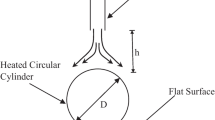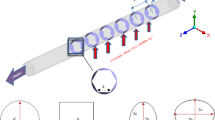Abstract
Velocity and wall temperature measurements, over flat plate, concave and convex walls, were experimentally investigated in a low-speed wind tunnel with inlet velocities of 4 and 12 m/s encompassing the transitional region with streamwise distance Reynolds numbers from 3.15×105 to 1.04×106. As the velocity profiles, recorded by a semi-circular pitot tube and a digital constant-temperature hot-wire anemometer, were compared to exact Blasius profile and (1/7)th power law, experimental local Stanton numbers to analytical flat plate solution and turbulent correlation formula. Intermittency factors, derived from velocities and local Stanton numbers, were presented both in streamwise and pitchwise directions. It was found that the convex curvature delayed transition up to Re x =1.04×106, with a mean intermittency value of 0.61 and a shape factor of 1.81, where the similar intermittency and shape factors were determined at Re x of 8.33×105 and 4.25×105 for the flat plate and concave wall, indicating the enhancing role of concave curvature on the transition mechanism. The thinner boundary layers of the concave surface resulted in higher intermittency values, corresponding to higher skin friction and Stanton numbers; moreover the lowest gap between the measured and derived Stanton numbers were also obtained over the concave surface. Destabilising role of the concave wall caused Stanton numbers to increase up to 22%, whereas the convex wall, due to its stabilising character, produced lower Stanton numbers by 12% with respect to those of the flat plate.







Similar content being viewed by others
Abbreviations
- A, a, b, c :
-
correlation constants (dimensionless)
- C f :
-
skin friction (dimensionless)
- C p :
-
constant pressure specific heat (J/kg K)
- h :
-
heat transfer coefficient (W/m2 K)
- H :
-
shape factor (dimensionless)
- q :
-
heat flux (W/m2)
- Pr:
-
Prandtl number (dimensionless)
- R :
-
radius of curvature (cm)
- Re x :
-
streamwise distance Reynolds number (dimensionless)
- Reθ :
-
momentum thickness Reynolds number (dimensionless)
- St:
-
Stanton number (dimensionless)
- T w :
-
wall temperature (°C)
- T o :
-
free stream temperature (°C)
- Tu:
-
turbulence level (%)
- u :
-
streamwise velocity (m/s)
- U :
-
mean free stream velocity (m/s)
- x, y, z :
-
streamwise, pitchwise and spanwise directions (mm)
- x l :
-
unheated starting length (mm)
- δ:
-
boundary layer thickness (mm)
- \(\varphi\) :
-
transition parameter (dimensionless)
- γ:
-
local intermittency factor (dimensionless)
- \(\bar{\gamma}\) :
-
mean intermittency factor (dimensionless)
- θ:
-
momentum thickness (mm)
- ν:
-
kinematic viscosity (m2/s)
- ρ:
-
density (kg/m3)
- τw :
-
wall shear stress (Pa)
- o:
-
flow-off
- f:
-
flow-on
- L:
-
laminar
- T:
-
turbulent
- te:
-
transition end
- ts:
-
transition onset
References
Narasimha R (1957) On the distribution of intermittency in the transition region of a boundary layer. J Aerospace Sci 24:711–712
Abu-Ghannam BJ, Shaw H (1980) Natural transition of boundary layers—the effects of turbulence, pressure gradient and flow history. Mech Eng Sci 22(5):213–228
Cheng KC, Obata T, Gilpin RR (1988) Buoyancy effects on forced convection heat transfer in the transition regime of a horizontal boundary layer heated from below. J Heat Trans—ASME Trans 110:596–603
Zumbrunnen DA, Aziz M (1993) Convective heat transfer enhancement due to intermittency in an impinging jet. J Heat Trans—ASME Trans 115:91–98
Ciofalo M, Di Piazza I, Stasiek JA (2000) Investigation of flow and heat transfer in corrugated–undulated plate heat exchangers. Heat Mass Trans 36:449–462
Zhou D, Wang T (1996) Combined effects of elevated free-stream turbulence and streamwise acceleration on flow and thermal structures in transitional boundary layers. Exp Therm Fluid Sci 12:338–351
Wang T, Keller FJ, Zhou D (1996) Flow and thermal structures in a transitional boundary layer. Exp Therm Fluid Sci 12:352–363
Johnson MW, Ercan AH (1999) A physical model for bypass transition. Int J Heat Fluid Flow 20:95–104
Vasudevan KP, Dey J (2000) Transition zone in constant pressure converging flows. Curr Sci 79(6):821–828
Schook R, de Lange HC, van Steenhoven AA (2001) Heat transfer measurements in transitional boundary layers. Int J Heat Fluid Flow 44:1019–1030
Zhang DH, Winoto SH, Chew TW (1995) Measurement in laminar and transitional boundary-layer flows on concave surface. Int J Heat Fluid Flow 16:88–98
Zhang DH, Chew YT, Winoto SH (1996) Investigation of intermittency measurement methods for transitional boundary layer flows. Exp Therm Fluid Sci 12:433–443
Volino RJ, Simon TW (1997) Measurements in a transitional boundary layer with Görtler vortices. J Fluids Eng—ASME Trans 119:562–568
Kestoras MD, Simon TW (1998) Conditionally sampled measurements in a heated turbulent boundary layer: curvature and free-stream turbulence effects. Exp Therm Fluid Sci 17:63–70
Toe R, Ajakh A, Peerhossaini H (2002) Heat transfer enhancement by Görtler instability. Int J Heat Fluid Flow 23:194–204
Volino RJ, Schultz MP, Pratt CM (2003) Conditional sampling in a transitional boundary layer under high freestream turbulence conditions. J Fluids Eng—ASME Trans 125:28–37
Muck KC, Hoffman PH, Bradshaw P (1985) The effect of convex surface curvature on turbulent boundary layers. J Fluid Mech 161:347–369
Wang T, Simon TW (1987) Heat transfer and fluid mechanics measurements in transitional boundary layers on convex-curved surfaces. J Turbomach—ASME Trans 109:443–451
Abu-Qudais M, Haddad OM, Maqableh AM (2001) Hydrodynamic and heat transfer characteristics of laminar flow past a parabolic cylinder with constant heat flux. Heat Mass Trans 37:299–308
Webster DR, Degraaff DB, Eaton JK (1996) Turbulence characteristics of a boundary layer over a two-dimensional bump. J Fluid Mech 320:53–69
Ligrani PM, Hedlund CR (1998) Transition to turbulent flow in curved and straight channels with heat transfer at high Dean numbers. Int J Heat Mass Trans 41:1739–1748
Wright L, Schobeiri MT (1999) The effect of periodic unsteady flow on aerodynamics and heat transfer on a curved surface. J Heat Trans—ASME Trans 121:22–33
Turner AB, Hubbe-Walker SE, Bayley FJ (2000) Fluid flow and heat transfer over straight and curved rough surfaces. Int J Heat Mass Trans 43:251–262
Ozalp AA, Umur H (2003) An experimental investigation of the combined effects of surface curvature and streamwise pressure gradients both in laminar and turbulent flows. Heat Mass Trans 39:869–876
Gostelow JP, Hong G, Walker GJ, Dey J (1994) Modelling of boundary layer transition in turbulent flows by linear combination integral method. ASME Paper No. 94-GT-358
Schubauer GB, Klebanoff PS (1955) Contributions on the mechanics of boundary layer transition. NASA TN-3489
Acknowledgements
This work is partly supported by the Uludag University Research Fund.
Author information
Authors and Affiliations
Corresponding author
Rights and permissions
About this article
Cite this article
Umur, H., Ozalp, A.A. Fluid flow and heat transfer in transitional boundary layers: effects of surface curvature and free stream velocity. Heat Mass Transfer 43, 7–15 (2006). https://doi.org/10.1007/s00231-005-0080-8
Received:
Accepted:
Published:
Issue Date:
DOI: https://doi.org/10.1007/s00231-005-0080-8




